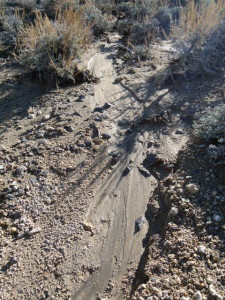On a day my brother was at work, my father and I decided to drive out to the Lodi Valley and hiked to the top of a peak overlooking a piece of property I had investigated on Google Earth adjacent to a mine that apparently is promised to begin operations after some test drilling is complete. Our eye level even with the tops of all ranges in every direction, we viewed row after row of wrinkles in the skin of the earth, thrust up from the valleys by volcanic swells, skirted by slump and turbidite (flow deposits of turbidinous currents). Volcanic flows are the most recent event in these ranges, overlaying many areas of the region’s upthrust rock formations, with some accumulation of sediment over the flow layers. This piques my curiosity as to when geologists estimate the recent volcanism occured in this area. Whenever it was, (and it cannot have been much more than 10,000 years ago, at or near the end of the Pleistocene Epoch, based on sediment accumulation) it was pervasive and violent. It would have been a nightmare to live through. It left a landscape that is angular and prickly, fissured and serrated, abrasive and yet, starkly beautiful.
In this landscape, you must take the opportunity to zoom in from the macrocosm to the microcosm and witness the patterns and forces working at a magnified scale. It is difficult for me to describe things in terms of scale, since all I have to refer to is human scale. But human scale is an arbitrary vantage point. If I want to describe something infinitely small but still observable, this is not the ‘minimal scale’. It is meaningless to use terms such as maximal or minimal…If I am looking at a cell in the skin of an elephant through a microscope, I am seeing the microcosm scaled up. If I am looking at Jupiter though a telescope, I am scaling the macrocosm down (or am I? Is it the reverse? Do you see the relativism that is confounding?). Scale is subject to perspective and is as relative as Einstein’s Theory of Relativity of Time…Imagine that from Earth, the surface of Jupiter is a static series of bands of colored gases. As you travel closer to the planet, the gases will have infinite patterns of turbulence, you will see slight movement, and as you descend into the orbital region, you will see patterns flowing and turbulence unfolding in the colored bands. As you descend further into the atmosphere, the turbulence will be experienced, equal to being in the thrust of a category 5 hurricane. From a distance, one does not witness the details or phenomena which are unfolding over time, you just see the whole (see even the word ‘whole’ does not work when applied to the concept of scale) and it appears static. At close proximity (whatever that means) phenomena like turbulence in liquids or gases have velocity. In this wonderland, each sagebrush is a plump gargantuan gnome, each lichen colony a vast urban sprawl of organic architectures spreading over the mineral rich rock faces, prevalent on the North sides, where I assume they take advantage of water condensation from the cold desert nights and retain hydration by living in zones of prevailing shadow.































